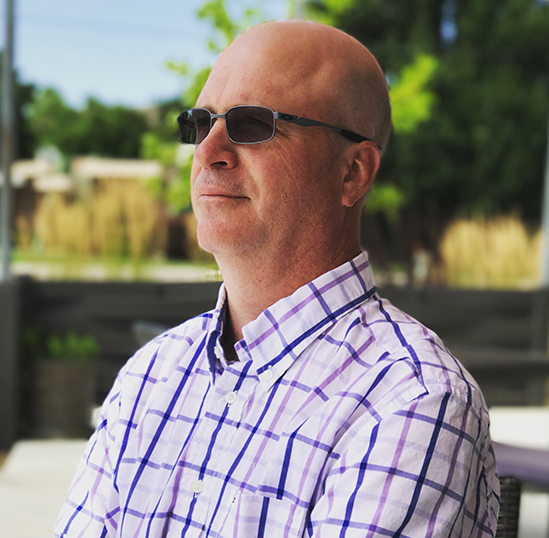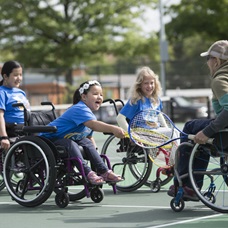Better Together
Idaho Youth Ranch’s new residential center, aided in part by St. Luke's, aims to fill a big void for young people in the state

The Idaho Youth Ranch has worked for years toward an enormous goal. And the more Scott Curtis worked toward that goal, the more he realized its importance.
The organization’s mammoth undertaking became a reality on Aug. 10, when the 258-acre Idaho Youth Ranch Residential Center for Healing & Resilience opened its doors.
“It’s been a huge project, and years in the making,” said Curtis, the CEO of the Idaho Youth Ranch.
The center is located in rural Caldwell, made possible by $35 million in contributions. It will seek to provide the physical, emotional and educational needs of the children and teens with the challenges of overcoming early-childhood trauma. It will feature 64 beds, a year-round school, a dining hall and indoor and outdoor recreation spaces.
“This project is a celebration of everything that is right about Idaho,” Curtis said. “Idahoans really came together to make this happen. … The campus really screams Idaho. I mean, there are thick forests and streams and ponds. There’s pasture land, there’s ag land. It’s a remarkable 258 acres, and it’s being retooled for Idaho’s kids. So, it’s really a celebration of so many people coming together.”
And having those services here in Idaho will be of vital importance.
According to the Idaho Youth Ranch, only five states have a higher incidence of adverse childhood experiences, with two in five high school students showing signs of depression, 23.2% of high school girls experiencing sexual violence and one in eight Idaho children living with someone struggling with mental illness or substance abuse.

Curtis singled out several members of St. Luke’s as being critical elements of the project coming to fruition.
“St. Luke’s has been supportive of this project all along, (not just) through financial support but also through resources and encouragement,” Curtis said.
Theresa McLeod, St. Luke’s administrator of community health and engagement, said she was especially proud of the multilayered approach St. Luke’s took in assisting the Idaho Youth Ranch center.
“We’ve had a rich history with the Idaho Youth Ranch,” McLeod said. “One of the opportunities I wanted to look at … was how St. Luke’s could use our assets and resources differently. So, rather than just consider a capital ask for funding, (we thought) ‘might there be additional ways that St. Luke’s could provide support to the Youth Ranch’s vision?’”
One example: Adrian Wengert, the vice president of supply chain, and his team determined some of the Idaho Youth Ranch’s equipment needs.
“The upshot of … that is a relationship was established and the Youth Ranch is able to benefit from our purchasing contracts, to some degree, for their purchasing needs,” McLeod said. “We’re able to negotiate some pretty great deals because of our buying power.”
Another example: Connie Sturdavant, practice director for St. Luke’s children’s mental and behavioral health, provided insight with her team about some of their successes and challenges in dealing with behavioral health for youth in Idaho.

Dr. Christopher Streeter, a child and adolescent psychiatrist, was one of the St. Luke’s providers who contributed his time and met with Idaho Youth Ranch staff.
“Connie and I worked with Scott and his team very closely … to provide them with our perspective and some of our lessons learned,” Dr. Streeter said. “They are absolutely doing the right thing. They have the right idea and they’ve been so thoughtful about what they’re doing.
“I’m just so impressed with their resilience and fortitude and perseverance in this super-important work.”
Curtis said he and other members of the Youth Ranch staff learned the importance of their work as they gained a deeper understanding of the obstacles youth with behavioral challenges face in Idaho.
“We learned that Idaho’s youth were actually being sent out of state for residential treatment, and that’s been going on for a long time,” Curtis said. “We heard about kids going to Florida, Georgia, Arkansas, Texas. … We had a youth who had come back from a facility in Arkansas, and she told us 13 of the 16 kids were from Idaho. That doesn’t make a lot of sense from a treatment standpoint.
“That’s one more trauma, being sent that far away from home, and it also limits family and caregiver interaction.”
Curtis also stresses that the new center will help keep Idahoans’ money in Idaho, unlike when young people are sent out of state.
“When we send kids to other states they don’t put those kids on their Medicaid, they stay on Idaho’s Medicaid,” Curtis said. “So, we’re paying for it, plus all the travel costs, plus the Department of Health and Welfare staff that have to fly to go visit the youth under the program.”
Dr. Streeter knows all too well how frustrating it can be for him, for the youth and for their families to be faced with additional challenges like that.
“It’s just such a pain for those of us that have been in the trenches for the last 10 years trying to help these kids,” Dr. Streeter said.
For that reason – and more – it’s safe to say that Dr. Streeter is excited to see the Idaho Youth Ranch Center for Healing & Resilience open its doors.
“It’s absolutely critical,” he said. “I think it’s going to be huge.”
About The Author

Chris Langrill is a writer and copy editor for the St. Luke’s Communications and Marketing department.



